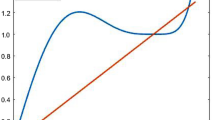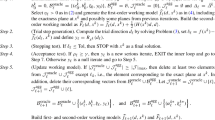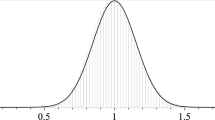Abstract
An accurate residual-time (AccuRT) restarting for computing matrix exponential actions of nonsymmetric matrices by the shift-and-invert (SAI) Krylov subspace method is proposed. The proposed restarting method is an extension of the recently proposed RT (residual-time) restarting and it is designed to avoid a possible accuracy loss in the conventional RT restarting. An expensive part of the SAI Krylov method is solution of linear systems with the shifted matrix. Since the AccuRT algorithm adjusts the shift value, we discuss how the proposed restarting can be implemented with just a single LU factorization (or a preconditioner setup) of the shifted matrix. Numerical experiments demonstrate an improved accuracy and efficiency of the approach.






Similar content being viewed by others
REFERENCES
M. Hochbruck and A. Ostermann, “Exponential integrators,” Acta Numer. 19, 209–286 (2010).
O. de la Cruz Cabrera, M. Matar, and L. Reichel, “Analysis of directed networks via the matrix exponential,” J. Comput. Appl. Math. 355, 182–192 (2019).https://doi.org/10.1016/j.cam.2019.01.015
P. Kürschner, “Balanced truncation model order reduction in limited time intervals for large systems,” Adv. Comput. Math. 44 (2018). https://doi.org/10.1007/s10444-018-9608-6
A. Frommer and V. Simoncini, “Matrix functions,” Model Order Reduction: Theory, Research Aspects and Applications, Ed. by W. H. Schilders, H. A. van der Vorst, and J. Rommes (Springer, Berlin, 2008), pp. 275–304.
L. Bergamaschi and M. Vianello, “Efficient computation of the exponential operator for large, sparse, symmetric matrices,” Numer. Linear Algebra Appl. 7 (1), 27–45 (2000).
A. H. Al-Mohy and N. J. Higham, “Computing the action of the matrix exponential, with an application to exponential integrators,” SIAM J. Sci. Comput. 33 (2), 488–511 (2011). https://doi.org/10.1137/100788860
I. Moret and P. Novati, “RD rational approximations of the matrix exponential,” BIT 44, 595–615 (2004).
J. van den Eshof and M. Hochbruck, “Preconditioning Lanczos approximations to the matrix exponential,” SIAM J. Sci. Comput. 27 (4), 1438–1457 (2006).
V. Druskin, L. Knizhnerman, and M. Zaslavsky, “Solution of large scale evolutionary problems using rational Krylov subspaces with optimized shifts,” SIAM J. Sci. Comput. 31 (5), 3760–3780 (2009).
S. Güttel, PhD Thesis (Tech. Univ. Bergakademie, Freiberg, 2010). www.guettel.com.
S. Güttel, “Rational Krylov approximation of matrix functions: Numerical methods and optimal pole selection,” GAMM Mitteilungen 36 (1), 8–31 (2013). www.guettel.com.
E. Celledoni and I. Moret, “A Krylov projection method for systems of ODEs,” Appl. Numer. Math. 24 (2–3), 365–378 (1997).
H. Tal-Ezer, “On restart and error estimation for Krylov approximation of w = f(A)\({v}\),” SIAM J. Sci. Comput. 29 (6), 2426–2441 (2007). https://doi.org/10.1137/040617868
M. Afanasjew, M. Eiermann, O. G. Ernst, and S. Güttel, “Implementation of a restarted Krylov subspace method for the evaluation of matrix functions,” Linear Algebra Appl. 429, 2293–2314 (2008).
M. Eiermann, O. G. Ernst, and S. Güttel, “Deflated restarting for matrix functions,” SIAM J. Matrix Anal. Appl. 32 (2), 621–641 (2011).
A. Frommer, S. Güttel, and M. Schweitzer, “Efficient and stable Arnoldi restarts for matrix functions based on quadrature,” SIAM J. Matrix Anal. Appl. 35 (2), 661–683 (2014).
T. Jawecki, W. Auzinger, and O. Koch, “Computable strict upper bounds for Krylov approximations to a class of matrix exponentials and \(\phi \)-functions,” (2018). https://arxiv.org/pdf/1809.03369.
M. Hochbruck and C. Lubich, “Exponential Integrators for quantum-classical molecular dynamics,” BIT 39 (4), 620–645 (1999).
M. Hochbruck, T. Pažur, A. Schulz, et al., “Efficient time integration for discontinuous Galerkin approximations of linear wave equations,” Z. Angew. Math. Mech. 95 (3), 237–259 (2015). https://doi.org/10.1002/zamm.201300306
R.-U. Börner, O. G. Ernst, and S. Güttel, “Three-dimensional transient electromagnetic modeling using rational Krylov methods,” Geophys. J. Int. 202 (3), 2025–2043 (2015).
M. A. Botchev, A. M. Hanse, and R. Uppu, “Exponential Krylov time integration for modeling multifrequency optical response with monochromatic sources,” J. Comput. Appl. Math. 340, 474–485 (2018). https://doi.org/10.1016/j.cam.2017.12.014
M. A. Botchev and L. A. Knizhnerman, “ART: Adaptive residual-time restarting for Krylov subspace matrix exponential evaluations,” J. Comput. Appl. Math. 364 (112311) (2020).https://doi.org/10.1016/j.cam.2019.06.027
J. Niehoff, PhD Thesis (Mathematisch-Naturwissenschaftlichen Fakultät der Heinrich-Heine-Universität Düusseldorf, 2006).
G. H. Golub and C. F. Van Loan, Matrix Computations, 3rd ed. (Johns Hopkins Univ. Press, Baltimore, 1996).
C. B. Moler and C. F. Van Loan, “Nineteen dubious ways to compute the exponential of a matrix, twenty-five years later,” SIAM Rev. 45 (1), 3–49 (2003).
N. J. Higham, Functions of Matrices: Theory and Computation (SIAM, Philadelphia, PA, 2008).
M. A. Botchev, V. Grimm, and M. Hochbruck, “Residual, restarting, and Richardson iteration for the matrix exponential,” SIAM J. Sci. Comput. A 35 (3), 1376–1397 (2013). https://doi.org/10.1137/110820191
B. N. Parlett, The Symmetric Eigenvalue Problem (SIAM, Philadelphia, PA, 1998).
H. A. van der Vorst, Iterative Krylov Methods for Large Linear Systems (Cambridge Univ. Press, Cambridge, 2003).
Y. Saad, Iterative Methods for Sparse Linear Systems, 2d ed. (SIAM, Philadelphia, PA, 2003). http://www-users.cs.umn.edu/~saad/books.html.
V. L. Druskin and L. A. Knizhnerman, “Two polynomial methods of calculating functions of symmetric matrices,” USSR Comput. Math. Math. Phys. 29 (6), 112–121 (1989).
L. A. Knizhnerman, “Calculation of functions of unsymmetric matrices using Arnoldi’s Method,” USSR Comput. Math. Math. Phys. 31 (1), 1–9 (1991).
M. Hochbruck and C. Lubich, “On Krylov subspace approximations to the matrix exponential operator,” SIAM J. Numer. Anal. 34 (5), 1911–1925 (1997).
V. L. Druskin, A. Greenbaum, and L. A. Knizhnerman, “Using nonorthogonal Lanczos vectors in the computation of matrix functions,” SIAM J. Sci. Comput. 19 (1), 38–54 (1998).
W. Hundsdorfer and J. G. Verwer, Numerical Solution of Time-Dependent Advection–Diffusion–Reaction Equations (Springer, Berlin, 2003).
R. Barrett, M. Berry, T. F. Chan, et al., Templates for the Solution of Linear Systems: Building Blocks for Iterative Methods (SIAM, Philadelphia, PA, 1994). www.netlib.org/templates.
Y. Saad and M. H. Schultz, “GMRES: A generalized minimal residual algorithm for solving nonsymmetric linear systems,” SIAM J. Sci. Stat. Comput. 7 (3), 856–869 (1986).
Y. Saad, Iterative Methods for Sparse Linear Systems, Book out of print (2000). www-users.cs.umn.edu/~saad/books.html.
R. B. Sidje, “Expokit: A software package for computing matrix exponentials,” ACM Trans. Math. Software 24 (1), 130–156 (1998). www.maths.uq.edu.au/expokit.
L. A. Krukier, “Implicit difference schemes and an iterative method for solving them for a certain class of systems of quasi-linear equations,” Sov. Math. 23 (7), 43–55 (1979).
A. Taflove and S. C. Hagness, Computational Electrodynamics: The Finite-Difference Time-Domain Method, 3rd ed. (Artech House, Boston, MA, 2005).
J. S. Kole, M. T. Figge, and H. De Raedt, “Unconditionally stable algorithms to solve the time-dependent Maxwell equations,” Phys. Rev. E 64, 066705 (2001).
J. G. Verwer and M. A. Botchev, “Unconditionally stable integration of Maxwell’s equations,” Linear Algebra Appl. 431 (3–4), 300–317 (2009).
M. A. Botchev, “Krylov subspace exponential time domain solution of Maxwell’s equations in photonic crystal modeling,” J. Comput. Appl. Math. 293, 24–30 (2016). https://doi.org/10.1016/j.cam.2015.04.022
Funding
This work is supported by the Russian Science Foundation grant no. 19-11-00338.
Author information
Authors and Affiliations
Corresponding author
Rights and permissions
About this article
Cite this article
Botchev, M.A. An Accurate Restarting for Shift-and-Invert Krylov Subspaces Computing Matrix Exponential Actions of Nonsymmetric Matrices. Comput. Math. and Math. Phys. 61, 684–698 (2021). https://doi.org/10.1134/S0965542521050031
Received:
Revised:
Accepted:
Published:
Issue Date:
DOI: https://doi.org/10.1134/S0965542521050031




